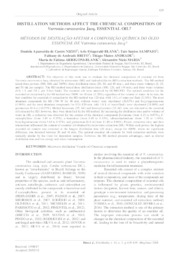Distillation methods affect the chemical composition of Varronia curassavica Jacq, essential oil?
Distillation methods affect the chemical composition of Varronia curassavica Jacq, essential oil?
Autoria: NIZIO, D. A. de C.; BLANK, A. F.; SAMPAIO, T. S.; BRITO, F. de A.; ANDRADE, T. M.; ARRIGONI BLANK, M. de F.; MARIA, A. N.
Resumo: The objective of this work was to evaluate the chemical composition of essential oil from Varronia curassavica Jacq. obtained by microwave (MI) and hydrodistillation (HD) extraction methods. The MI method tested three powers (500, 600, and 700W), three distillation times (20, 30, and 40 min.), and three water volumes (0, 25, and 50 mL per sample). The HD method tested three distillation times (100, 120, and 140 min.) and three water volumes (1.0, 1.5, and 2.0 L per 3-liter flask). The essential oils were analyzed by GC/MS-FID. The optimal condition for the essential oil extraction by the MI method was 700W for 40 min. (3.28%), regardless of the volume of water. In its turn, the best condition for essential oil extraction by the HD method was 120 min. with 1.0 L of water per flask (3.34%). The most abundant compounds for MI (700 W for 40 min. without water) were shyobunol (26.53%) and bicyclogermacrene (4.96%); and the most abundant compounds for HD (120 min. with 1.0 L of water/flask) were shyobunol (24.00%) and germacrene D-4-ol (10.23%). Methyl farnesoate (2E, 6E) and farnesyl acetate (2Z, 6E) were not detected in the essential oil extracted by HD; however, they were identified by the MI method. By increasing the distillation time and/or volume of water in HD, a reduction was observed for the content of the chemical compounds -elemene (from 1.23 to 0.97%), Ecaryophyllene (from 5.49 to 4.35%), -humulene (from 1.80 to 1.43%), alloaromadendrene (from 1.78 to 1.44%), bicyclogermacrene (from 5.63 to 4.55%), and germacrene D-4-ol (from 11.40 to 9.86%). Power, extraction time, and their interactions influenced the content of essential oil obtained by microwave extraction (MI). Within each power, the highest essential oil content was extracted at the longest distillation time (40 min.), except for 600W, where no significant difference was detected between 30 and 40 min. The optimal essential oil contents for both extraction methods were statically similar by the t-test for dependent samples. However, the MI method presents advantages, such as shorter distillation time and less energy and water consumption.
Ano de publicação: 2018
Tipo de publicação: Artigo de periódico
Unidade: Embrapa Tabuleiros Costeiros
Palavras-chave: Essential oils, Varonia curassavica Jacq, Óleo Essencial
Observações
1 - Por padrão são exibidas publicações dos últimos 20 anos. Para encontrar publicações mais antigas, configure o filtro ano de publicação, colocando o ano a partir do qual você deseja encontrar publicações. O filtro está na coluna da esquerda na busca acima.
2 - Para ler algumas publicações da Embrapa (apenas as que estão em formato ePub), é necessário ter, no celular ou computador, um desses softwares gratuitos. Sistemas Android: Google Play Livros; IOS: iBooks; Windows e Linux: software Calibre.
Acesse outras publicações
Acesse a Base de Dados da Pesquisa Agropecuária (BDPA) para consultar o acervo completo das bibliotecas da Embrapa.

